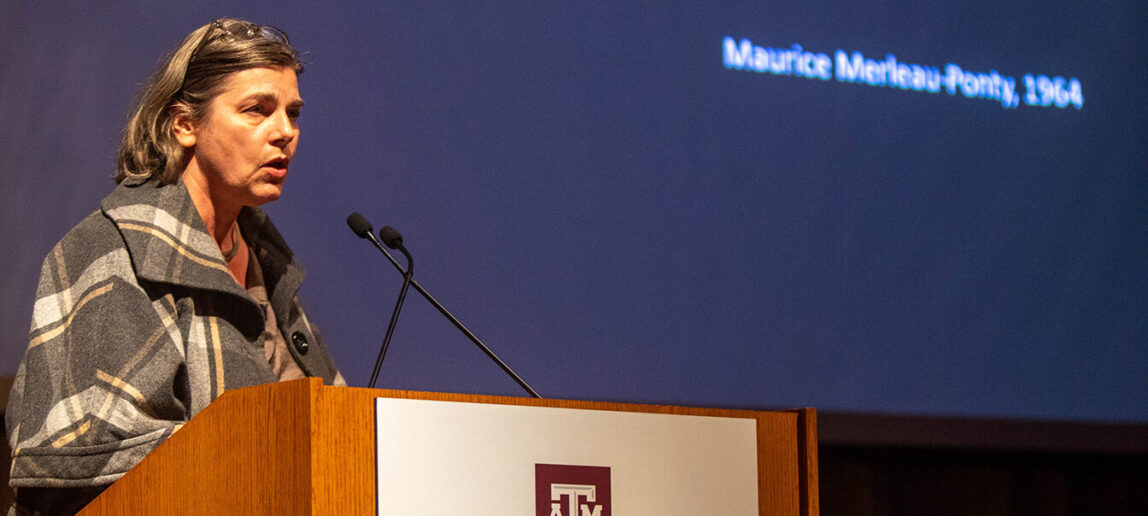Research Spotlight: Dr. Dawna Schuld Examines Artist Residencies In Cold War Industrial Settings Through Arts And Humanities Fellowship
Dr. Dawna Schuld, associate professor in the College of Performance, Visualization and Fine Arts, is in the midst of a book project as part of Texas A&M University’s Arts and Humanities Fellowship Program through the Division of Research.
Each fellow is chosen by a peer-review committee from project-based applications, and receives a three-year grant totaling $15,000. Dr. Tianna Uchacz, assistant professor in the College of Performance, Visualization and Fine Arts, also received the fellowship.
Schuld’s book will examine the role of artists who served in residencies in scientific and industrial settings during the Cold War in the United States and the United Kingdom. Her goal is to challenge assumptions regarding interdisciplinary research, the nature of creativity and innovation, and the power dynamic between the arts and sciences.
“I want to bring debates about those things to the forefront because we have become rather complacent in accepting corporatized definitions; and it does not always benefit the arts,” Schuld said. “The artists I’m writing about often acted as irritants and asked a lot of questions. But in the process, did a lot of good for the arts and individuals working in those organizations.”
Schuld said she was delighted to be awarded the fellowship, as it allows her to find answers and explore new archives.
“The fellowship allows me to do all of the primary source research, get to these places, talk to people and do it properly,” she said. “It’s validation, which is also encouraging, in that it allows me to do what I want to do.”
A newfound artistic perspective began after a push in the 1960s to revitalize art with new and more accessible technology and materials, Schuld said, and started a new way of thinking about art as systems of engagement instead of objects. Schuld found that engineers who collaborated with scientists and other industry makers viewed their work from this new approach.
“It was a very short period of movement,” Schuld said. “The growth of the defense industry during the Vietnam War in particular increased opportunities for collaboration but also invited pushback.”
Industry makers were recruiting artists to create art, while funding their residencies in places like California and London, Schuld said. She was curious why artists were interested in these partnerships, and why industry makers wanted to bring them in.
“Typically, artists’ residencies were in a separate space carved out by artists, for artists,” Schuld said. “There are a lot of different art residency spaces around North America. But in this case, artists were introduced to somebody in a factory who said: ‘Here, collaborate.’ Artists were introduced to engineers and scientists, and the idea was this would give them access to new materials and new ways of thinking.”
During the Cold War, new technologies and new materials were funded by defense industries through contracts with artists in the U.S. and the U.K., Schuld said.
“In some cases, I see it as an early version of ‘art-washing,’” she said. “As is the case today, wealthy donors may sprinkle their name all over the art world to show they are supporting culture. Something similar was happening with these defense contractors who were bringing in artists. It’s not inherently bad, but also basically a promotional thing to say: ‘See? We support the arts.’”
By studying these partnerships, Schuld found the artwork produced wasn’t what industry makers originally anticipated. They expected to see paintings and figurines, or a depiction of the work they produced, Schuld said. However, the artists were more likely to focus on exploring the materials and their new environment, she said.
A lot of the art projects didn’t produce any identifiable objects, she said. The experience and opportunities were impactful to the artist, while less significant for the industrial partners, Schuld said.
Helen Pashgian of Pasadena, California, is one of the artists Schuld is studying for her research. Pashgian partnered with the California Institute of Technology as an artist in residence in 1971, to understand the nature of art materials she worked with like plastic and resin, Schuld said.
“For Pashgian, it was really formative,” Schuld said. “For the school, it was kind of a ‘nice thing’ they did for the community. There is a real imbalance there, which is what I’m trying to address. We hear repeatedly how interdisciplinarity will produce new and better research, yet if there is a power imbalance, I don’t see how that’s necessarily overcome with these kinds of programs.”
Schuld said she hopes readers will find a balance in the arts and sciences, similar to how these artists explored new ways of creating.
“Don’t limit art to your own expectations,” she said. “It doesn’t have to adhere to rules. That is what makes it art. Don’t be afraid of failure because that’s the territory where real innovation emerges.”

